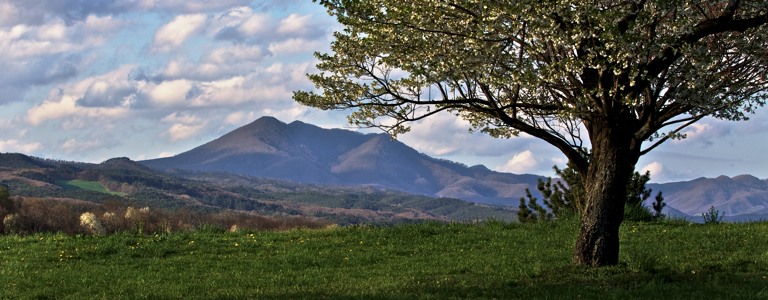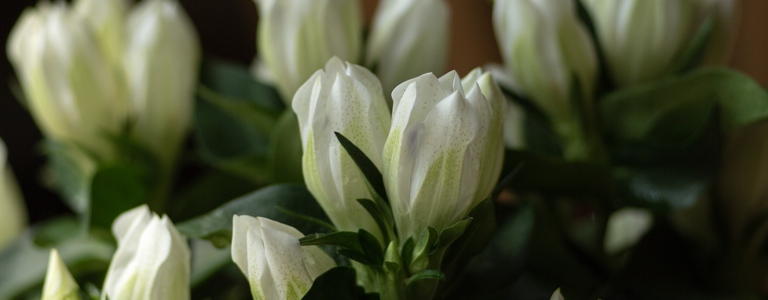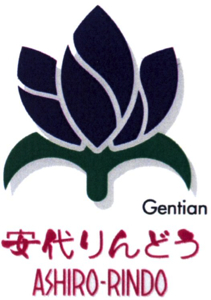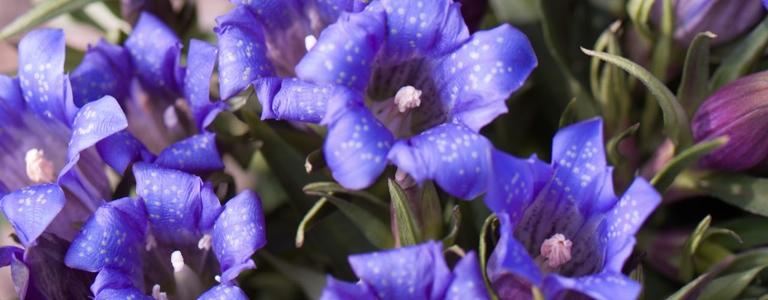Ashiro Rindo, Japan
Facing the Pacific Ocean to the east, Iwate – the second largest prefecture in Japan – is characterized by lush forests, clear rivers, and some of the country’s most famous onsen (hot springs). In the shadow of the Ou Mountains in the northwest part of Iwate, bordering neighboring Akita prefecture, is Ashiro, a community of approximately 6,000 that is famous for more than just relaxing onsen. In this peaceful community in the mid 1950s, a new plant variety emerged – AshiroRindo. Named after the community of Ashiro and Rindo, the Japanese word for gentian (hardy alpine flowers), the strikingly beautiful flower has proven to be one of Ashiro’s most well-known and successful exports.

Goods with specific geographical origin
Gentians are hardy plants that grow on all continents except Antarctica and thrive in a variety of climates– from deserts and savannas to rainforests and tundra. The environment in which the plant grows plays a significant role in its appearance and lifecycle. For example, gentians can be small, seasonal herbs in dry climates, or large, tree-like plants in rainforests. The plant’s flowers also vary in appearance, and can be blue or white for those plants growing in colder climates, while pink or red for those varieties growing in warmer climates. Closely related to other plants such as coffee, milkweed, and periwinkle, there are 87 genera and over 1,600 species of gentians growing around the world. AshiroRindo (Gentiana triflora), is one of over 400 species that belong to the Gentiana genus of the Gentian family. Most species of Gentiana occur in the forests and plains of temperate, alpine climates in Asia, and grow at an elevation of 600 – 1,000 meters.
AshiroRindo is a unique type of Gentiana triflora that occurs as a wild alpine flower in Japan, and the environmental conditions of the region give the plant its characteristics. With mountains rising to over 2,000 meters high, the cool temperatures (an annual average of 8.7 degrees Celsius) make for perfect alpine conditions. Gentiana thrives in neutral to acidic soil that has excellent drainage and is rich in humus (organic matter found in soil), which is characteristic of Ashiro soil. Moreover, Gentiana plants require ample rain and sunshine, and with over 1,200 millimeters of annual rainfall and nearly 2,000 hours of yearly sunshine (approximately 5.5 hours per day), Ashiro has plenty of both. All of these environmental characteristics provide the perfect conditions for gentians to grow, with the wild plants in the Ashiro region featuring deep blue or rich azure flowers.
Research and development
In the late 1960s, rice farmer Hideo Kudo found it difficult to support his family in Ashiro solely with his yearly harvest. To supplement his income, every winter he left his family and went to Tokyo to work in the construction industry. However, Mr. Kudo found this took an emotional toll on him and his family. “It was really hard to leave my wife alone,” he explained. Resolving to stay close to his family in Ashiro during the cold winter months, in 1971 Mr. Kudo and a few other Ashiro farmers decided to pool their resources together and form a collective – Ashiro Gentian Growers (AGG) – and take the risky move of farming flowers. In the mountains and hills of Ashiro, wild, deep blue gentians, which are particularly prized in Japan due to their significance in Buddhist ceremonies (such as in rituals and memorial services), grow freely. With an abundance of perennial wild blue gentians growing freely around them, Mr. Kudo and his team decided that it was the perfect flower to start with.

Large-scale cultivation of wild gentians started in Iwate prefecture around 1955, and Mr. Kudo’s initiative a decade later came about at just the right time, as demand for gentians in Japan increased and the industry was starting to take off. Compared to gentians, cultivation of rice takes ten times as much land, so the farmer and his partners found themselves with a significant amount of acreage and gentian cultivation capacity. Within one year of establishing the collective, the gentian cultivation initiative was so successful that Mr. Kudo no longer had to work in Tokyo during the winter. With the climate well suited for cultivation, the farmer and his partners decided that they could grow even more beautiful gentians of higher quality, and increase the collective’s economic viability, if they undertook research and development (R&D) to develop new varieties. Desirable traits included gentians with different flower colors (such as white and pink) and tones, uniquely shaped leaves, and plants that could also bloom in off-season.
In 1972, the collective started working with a specialist at a local horticultural laboratory and developed the first new gentian variety – the Iwate gentian, named after Iwate prefecture. By 1980 cultivation of the Iwate gentian was in high gear, and it quickly became the most popular gentian grown among farmers in Ashiro.This first new variety heralded the beginning of the development of a number of successful new gentian varieties in the following decades.Mr. Kudo and AGG continued to develop new varieties specifically for the Ashiro climate. In the 1990s, two new varieties – Ashiro no Aki and Ashiro no Natsu (autumn gentian and summer gentian, respectively) – were developed. Both varieties have unique traits. Ashiro no Aki features flowers that are very deep blue in color, and the variety has become one of the most recognizable Ashiro gentians. Ashiro no Natsu was developed to be an early blooming gentian, and can be shipped from greenhouses as early as late June. By the mid-2000s, these varieties had a 30% share of the domestic Japanese gentian cut flower market.
The techniques that AGG used to develop its first new gentian variety continue to be used. To remain competitive, these techniques included ensuring high standards are met for all new varieties. For example, the color and tone of the flowers, the size of the leaves, and the symmetry of leaf clusters must all be aesthetically pleasing in a unique way compared to other varieties. To achieve this, the first step in developing a new gentian variety is to decide the desirable target characteristics. Once the decision has been made, existing varieties are randomly crossed until Candidate Pairs are discovered. Candidate Pairs are those combinations of existing varieties that are likely to produce progeny plants with the desired characteristics (such as a particular flower color). After successfully isolating Candidate Pairs, male and female Parent Lines, are established to ensure that a particular pair does in fact produce child plants with the desired characteristics. These lines are grown via tissue culture (separate from the original plant in a growth medium such as a special liquid or gel) until they are ready to be transplanted into pots, where they grow and eventually yield seeds.
With seeds in hands, male and female plants are propagated and stored in cold temperature. Shoots to lay down roots of each plant are carefully prepared by hand and, when ready, the female plants are pollinated individually by hand. Even if the new varieties grow, success is not assured. The new plants must first bloom, and this only happens in the plant’s second year of life. Next, in the plant’s third year, its true characteristics and potential will finally manifest, and it is only then that the new variety is ready for cultivation. However, each variety is different, and it can take up to ten years for a new variety to grow successfully and be ready for sale. Seeds of new varieties are not distributed to farmers until they are guaranteed to produce a plant with the desired traits. The time and labor intensive nature of developing new gentian varieties means that the R&D must be carefully undertaken, as a lost variety could also mean the loss of many years of work and potential future income.
Partnerships
To assist AGG and other farmers with cultivation of new gentian varieties, in 1992 the Ashiro town government launched the Ashiro Town Floriculture Development Center, which is now known as the Hachimantai Floriculture R&D Center (HFC).The change is the result of the merger of Ashiro with the neighboring town of Nishine and village of Matsuo to form the city of Hachimantai in September 2005. The main task of the Center is to work with local gentian farmers and help them develop new gentian varieties that can be successfully cultivated in Ashiro. In return, the farmers donate 2% of their sales to HFC to support further R&D. After the Center successfully develops a new variety, high quality seeds are produced and HFC distributes them to participating farmers. The Center also provides the famers with vital technical assistance, as cultivating a new variety is an endeavor that requires great skill. Once farmers successfully grow the new variety, it is cut and sold under the “Ashiro” gentian brand. The partnership between AGG, HFC, and other Ashiro gentian farmers is essential to the continued success of the Ashiro gentian brand.

With the domestic popularity of Ashiro gentian plants continually expanding, HFC and AGG decided to take their new varieties to the international market. In 2005, the Center and the collective joined forces with Mr. John Moffatt, one of the premiere gentian growers in New Zealand and owner of Southland Flowers, and scientists at the New Zealand Institute for Plant and Food Research Ltd. (IPF), to share genetic material and grow the Ashiro gentian varieties in New Zealand. The advantage of this partnership served three main purposes. First, because of New Zealand’s location in the southern hemisphere, it could provide Ashiro gentians to the Japanese market during Japan’s off-season. Second, it would help internationalize the Ashiro brand and expand the gentian industry. Finally, working with Mr. Moffatt and IPF could lead to the creation of even more gentian varieties, such as those that could withstand greater temperature variation.
The result of this partnership led to the creation of a new company – Rindo International Ltd. (RI) – which has four shareholders – the city of Hachimantai, AGG, IPF, and Mr. Moffatt. Under the terms of the partnership, RI owns the intellectual property (IP) rights, such as Plant Breeders’ Rights (PBRs), to all jointly developed varieties with genetic material coming from Japan and New Zealand. Plants are exchanged via tissue culture and pollen, and the breeding is undertaken at HFC in Japan, at IPF, and at Mr. Moffatt’s farm in New Zealand. Even though new plants must be quarantined for three years before they can undergo trials in New Zealand, the partnership has resulted in the development of many new unique gentian varieties, such as those with pink, yellow, purple, and red flowers, with many more continually in the works.
Plant variety protection
Since the introduction of the first Ashiro Iwate gentian, HFC has been granted PBRs for 11 new varieties by the Ministry of Agriculture, Forestry and Fisheries (MAFF) of Japan, under the Plant Variety Protection System in line with the International Union for the Protection of New Varieties of Plants (UPOV) Convention, and as of 2012 had PBRs for 13 more new varieties pending. Included among these granted titles (see the Plant Variety Database, PLUTO, operated by UPOV) are varieties that have been licensed in New Zealand and Chile, such as Ashiro no Natsu(Registration No.7473), Ashiro no Hatsuaki(Registration No. 15090), and Ashiro no Aki (Registration No. 4995). Through the efforts of the collective, RI, and Mr. Kudo, new Ashiro Rindo varieties are continuing to be developed. For example, in 2012 HFC had six new varieties in the pipeline that will eventually be filed with MAFF.
Licensing
When Mr. Kudo and his fellow farmers at AGG first started working with Southland Flowers, their ten most popular varieties (including Ashiro no Aki and Ashiro no Natsu) were licensed to the New Zealand based company. The aim of this licensing agreement was to produce new varieties in New Zealand that had different colored flowers (pink and red were the first target colors) and could complement the off-season in Ashiro. Once RI was formed, the partnership became the owner of all new IP resulting from the licensing agreements. Beyond the New Zealand licensing scheme, HFC and AGG also entered into licensing agreements with growers in the Republic of Chile (Chile) in the mid 2000s, again licensing the rights to the ten most popular Ashiro varieties. The agreements with Chilean growers are primarily to ensure that Ashiro gentians are available year-round. This is because of the reverse in seasons between Chile and Ashiro (when it is winter in Ashiro, it is summer in Chile), which provide cultivation throughout the year. Plants from the Chilean licensing agreement are also sold to the European and North American markets.
Branding and trademarks

(Madrid System Registration #963353)
As the popularity of gentians from Ashiro increased, the region’s name quickly became synonymous with high quality gentians. Although Mr. Kudo’s and AGG’s gentians were sold as Ashiro gentians for decades, there was no specific branding mechanism in place. When the town merged with its neighbors to form Hachimantai city in 2005, the new government made it a point to promote their city, its natural resources, and famous products through branding. Ashiro Rindo was at the top of their list. Integral to the government’s branding strategy was strengthening and highlighting the quality and consistency of the flowers, thereby increasing their market value and reputation. By doing so, Ashiro Rindo developed into a brand known for high-class gentians, and thus earned a premium compared to competitor brands.
Commensurate with AGG’s branding strategy is the use of the IP system to protect the Ashiro Rindo name. To that end, in April 2008 the company filed a trademark application for the Ashiro Rindo name and stylized logo in AGG’s most important markets via the Madrid System for the International Registration of Marks (the Madrid System), managed by the World Intellectual Property Organization (WIPO). The application, based on a Japanese national application (registration #5173992), designated the People’s Republic of China, the European Union (EU), the Republic of Korea, and the United States of America (USA). The mark was registered in June 2009 in the EU and in July 2009 in the USA.
Commercialization
Over 300 farmers in the Ashiro area of Hachimantai city, Iwate prefecture, cultivate varieties of Ashiro gentians for commercialization. Once ready, the flowers are cut and packed in Ashiro Rindo branded containers and then shipped throughout Japan and to international markets (predominantly North American and European markets). When Ashiro gentians were first commercialized in the 1950s, they were sold locally and also in flower markets and auctions in major urban centers, such as the Ota Flower Auction that is still held daily in Tokyo. HFC and AGG soon found that Ashiro Rindo’s popularity meant it was difficult to keep up with demand, especially in the winter off-season. To better meet demand, in 1999 the two entities entered into the licensing agreement with Southland Flowers and started cultivating Ashiro Rindo varieties in New Zealand. At the outset, the purpose of the agreement was to provide Ashiro Rindo varieties to the Japanese market during the winter. A few years later, Mr. Moffatt suggested that they could earn more if they sold the prized flowers in Europe and North America.
Taking this suggestion to heart, HFC and AGG launched an export initiative that resulted in the first international sales of Ashiro Rindo varieties in the USA and the Kingdom of the Netherlands (the Netherlands) in 2002. When the flowers made their first international appearance, it took up to seven days for them to reach their destination. However, in 2005 HFC and AGG were able to decrease this to three to four days. At the same time, they introduced new freezing technologies that could maintain the plants’ maximum freshness, and demand for Ashiro Rindo increased. This increase in demand was particularly true in the Netherlands, as Ashiro Rindo varieties were completely new to the market, providing consumers with different colors, shapes, and sizes, and thus commanding a high premium. By the late 2000s, there were over 7 million Ashiro Rindo cut stems imported annually by the Netherlands alone. The popularity of Ashiro Rindo cut stem varieties in the Netherlands has therefore proven the country to be an important market for the cooperative and RI. Moreover, through intensive R&D efforts, varieties of Ashiro Rindo have been developed that thrive in nearly any climate, and combined with licensing and partnerships, are commercialized domestically and internationally throughout the year.

Licensed plant varieties, such as those originally licensed to Southland Flowers, are cultivated, prepared, and sold by each respective licensee, with appropriate royalties making their way to Ashiro through HFC. With the development of Southland Flowers’ new varieties, the company works with RI to directly commercialize the sale of the new plants. In September 2011, AGG expanded their scope and exported Ashiro Rindo to Hong Kong, China. By 2012, through the efforts of Ashiro Rindo growers and their partners such as HFC, AGG, RI, and Southland Flowers, popular varieties of Ashiro Rindo are sold in many international markets such as Asia, Oceania, Europe, and North and South America. Furthermore, the partnerships and commercial activities in New Zealand and South America in particular ensure that the culturally important flower is available in Japan at any time during the year in a myriad of colors.
Business results
The efforts of Mr. Kudo, AGG, and HFC have resulted in increased demand for Ashiro Rindo varieties in and out of Japan, and farmers and their communities in Ashiro have enjoyed significant economic benefits. Ashiro Rindo is the most well-known, produced, and sold gentian in Japan, and the new varieties produced from the New Zealand – Japan partnership have also proved successful. For example, when the first pink Ashiro Rindo was shipped from New Zealand to Japan, North America, and Europe in 2007, RI found it difficult to keep up with demand. Moreover, successive varieties formed through the partnership (such as purple, yellow, and red) have continued to ensure the competitiveness and success of Ashrio Rindo. As of 2012, the Ashiro region takes in US$13 million annually through sales of Ashiro Rindo cut stems, and the brand has become one of the world’s most desired gentian varieties.
Planting in firm ground
When one rice farmer started to look for a better way to support and stay closer to his family, he made a decision that reverberated throughout his community, Japan, and around the world. Developing new gentian varieties, forming a cooperative, and fostering international partnerships provided Japan with yearly availability of a culturally important plant whose noble and serene beauty has become a favorite for people throughout the world. Mr. Kudo, together with his son Yoshiteru (who recently took over from his father), looks forward to a bright future for their business and agriculture in the region. Ensuring the development of a strong brand and protection through the IP system via new plant varieties and trademarks, Ashiro Rindo continues to plant the seeds for the next generation.
Source: WIPO

 Client Focus
Client Focus